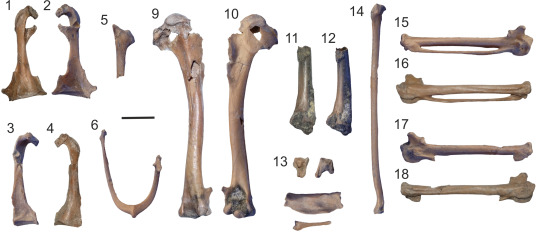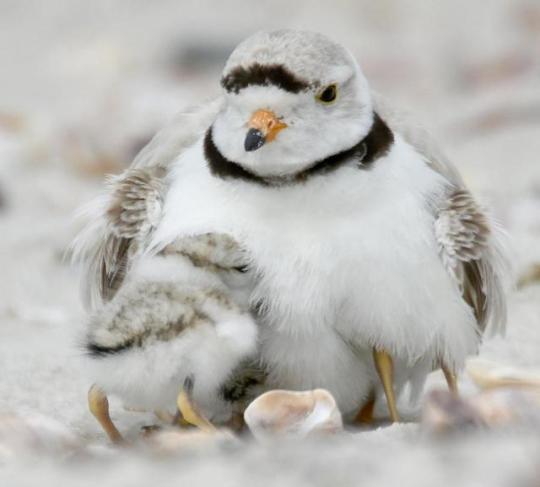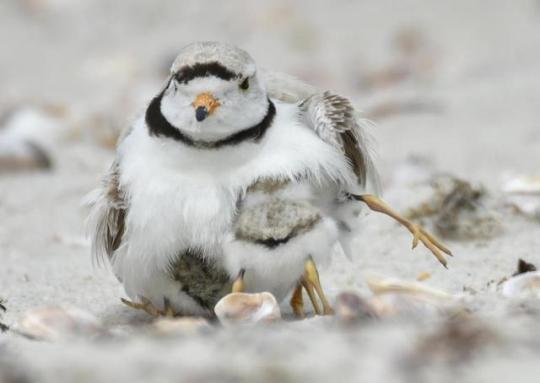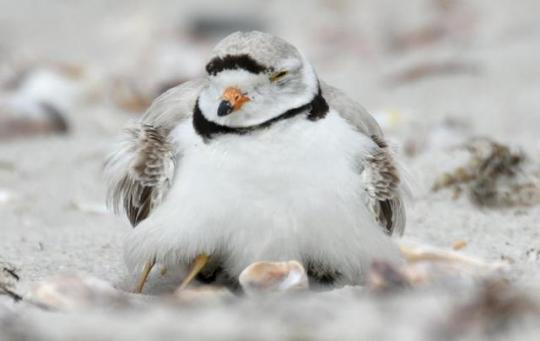#Charadrii
Explore tagged Tumblr posts
Text

[2995/11080] Double-striped thick-knee - Burhinus bistriatus
Note: Clements places this bird in the genus Hesperoburhinus.
Order: Charadriiformes Suborder: Charadrii Family: Burhinidae (stone-curlews)
Photo credit: Jhon Velasquez via Macaulay Library
#birds#Double-striped thick-knee#Charadriiformes#Charadrii#Burhinidae#Burhinus#birds a to z#undescribed#25% - 50%#Hesperoburhinus
136 notes
·
View notes
Text
Charadriisimilis essexensis Mayr & Kitchener, 2023 (new genus and species)

(Wing and shoulder bones of Charadriisimilis essexensis [scale bar = 5 mm], from Mayr and Kitchener, 2023)
Meaning of name: Charadriisimilis = similar to [in Latin] Charadrii; essexensis = from Essex
Age: Eocene (Ypresian), 54.6‒55 million years ago
Where found: London Clay Formation, Essex, U.K.
How much is known: Partial skeleton of one individual including parts of the shoulder girdle and forelimbs.
Notes: Charadriisimilis was a shorebird. More specifically, it appears to have been a close relative to Charadrii, a group of shorebirds that includes modern plovers, stilts, and oystercatchers, among others. Fossils of early Paleogene shorebirds are very sparsely known, so as one of the oldest and most completely known modern-type shorebirds found so far, Charadriisimilis is an important discovery for understanding the early evolution of this group of birds.
Reference: Mayr, G. and A.C. Kitchener. 2023. Early Eocene fossils elucidate the evolutionary history of the Charadriiformes (shorebirds and allies). Journal of Paleontology advance online publication. doi: 10.1017/jpa.2023.51
37 notes
·
View notes
Photo

American oystercatcher (Haematopus palliatus)
Photo by Peter Brannon
#predation#american oystercatcher#haematopus palliatus#haematopus#haematopodidae#charadrii#charadriiformes#aequorlitornithes#neoaves#neognathae#aves#therapoda#archosauria#sauropsida#reptilia#tetrapoda#vertebrata#chordata
15 notes
·
View notes
Photo

Prowling cat decimates banded dotterel colony for second breeding season | Stuff.co.nz
A lone cat is thought to be responsible for another disastrous breeding season at an embattled native shorebird colony.
A solitary fledgling was tagged this season at the Eastbourne banded dotterel colony, the lone survivor from 14 nests established along the roughly 300-metre long stretch of beach on the eastern shores of Wellington Harbour in Lower Hutt.
Parker Jones, co-ordinator from the Mainland Island Restoration Organisation (MIRO), said it appeared a domestic tabby cat, which had repeatedly been caught on camera terrorising the colony, all but wiped out the eggs and chicks. It is believed the same cat had been responsible for predating the colony last year, when not a single bird born at the site survived.
The cat had evaded a live catch trap at the beach. A trapping programme that targets most other mammalian predators protects the colony.
The ground nesting birds, which the Department of Conservation classifies as nationally vulnerable, typically lay three eggs per nest.
Many of the dotterel pairs had renested two or three times and Jones said it had been hard for volunteers monitoring the site to keep finding the chicks disappearing overnight.
The dotterels had left the colony early this year which Jones said was evidence the adults, which did not appear to have been predated, had given up for the season.
#Double-banded Plover#Charadrius bicinctus#Charadrius#Charadriidae#Charadrii#Charadriiformes#Aves#birds#shorebird#plover#predation#nesting#feral cats#invasive species#New Zealand
76 notes
·
View notes
Text
Phegornis mitchellii

By Francesco Veronesi, CC BY-SA 2.0
Etymology: Splendorous Bird
First Described By: Gray, 1846
Classification: Dinosauromorpha, Dinosauriformes, Dracohors, Dinosauria, Saurischia, Eusaurischia, Theropoda, Neotheropoda, Averostra, Tetanurae, Orionides, Avetheropoda, Coelurosauria, Tyrannoraptora, Maniraptoromorpha, Maniraptoriformes, Maniraptora, Pennaraptora, Paraves, Eumaniraptora, Averaptora, Avialae, Euavialae, Avebrevicauda, Pygostaylia, Ornithothoraces, Euornithes, Ornithuromorpha, Ornithurae, Neornithes, Neognathae, Neoaves, Aequorlitornithes, Charadriiformes, Charadrii, Charadriida, Charadriidae, Charadriinae
Status: Extant, Near Threatened
Time and Place: Within the last 10,000 years, in the Holocene of the Quaternary


The Diademed Plover can be found along the Pacific coast of South America

Physical Description: The Diademed Plover is a beautiful and distinctive wading bird, though quite small for its group - never growing longer than 20 centimeters in length. It has a long, thin bill, like other plovers, and a very black head with a white ring around the top of the head - hence its name, Diademed, as it looks like it has a crown on its head. It has a red patch on the back of its neck, and the front of its neck is white; while its belly and rump are white with black stripes. The back of the Diademed Plover, meanwihle, is brown. It has long, thin, and yellow legs; while its wings are rather short, leading to an undulating flight style. All sexes look alike, while the juveniles look more grey and less distinctive.
Diet: The diet of the Diademed Plover is uncertain at this time.
Behavior: Though its diet may be murkey, the Diademed Plover does have some known feeding habits, such as feeding in hidden spots - especially eroded holes and creeks. They will probe the ground with their bill, and pick off food from aquatic plants. They usually forage alone, or in mated pairs, but no more than that. They call to each other while foraging, making “pic pic pic” sounds; they make quiet chattering when meeting up after being separated. They also make sharp whistling calls as alarms.

By Opisska, CC BY-SA 4.0
The Diademed Plover breeds in the puna zone of the Andes, not nesting very closely together; They nest from October through January, with most nesting occurring in December. Two small eggs are laid in their nests, which are made of dried grass. The chicks are mainly dark brown and fluffy. These birds don’t migrate much, but they do go back and forth between altitudes depending on the season.
Ecosystem: The Diademed Plovers live in the Puna grassland ecoregion of South America, a habitat of high elevation grasslands in the Andes mountains near the Pacific ocean. The Diademed Plover mainly lives in mossy tundra and bogs, as well as in grasslands near lakes.
Other: The Diademed Plover is considered near threatened, given that it is poorly known and seems to have a small population size (probably around 10,000 individuals). They are easily overlooked and their high altitude makes recording their population difficult, but it also means they are probably at least somewhat secure in at least part of their range.
~ By Meig Dickson
Sources under the Cut
Jobling, J. A. 2010. The Helm Dictionary of Scientific Bird Names. Christopher Helm Publishing, A&C Black Publishers Ltd, London.
Wiersma, P. & Kirwan, G.M. (2019). Diademed Plover (Phegornis mitchellii). In: del Hoyo, J., Elliott, A., Sargatal, J., Christie, D.A. & de Juana, E. (eds.). Handbook of the Birds of the World Alive. Lynx Edicions, Barcelona.
#Phegornis mitchellii#Phegornis#Diademed Plover#Plover#Dinosaur#Dinosaurs#Bird#Birds#Diademed Sandpiper-Plover#Sandpiper#Charadriiform#Aequorlitornithian#South America#Quaternary#Omnivore#Water Wednesday#Birblr#Factfile#biology#a dinosaur a day#a-dinosaur-a-day#dinosaur of the day#dinosaur-of-the-day#science#nature#Dìneasar#דינוזאור#डायनासोर#ديناصور#dínosaurio
58 notes
·
View notes
Note
What characters support the basal position of auks in Strauch (1978) & Dove (2000)?
Strauch (1978) found a polytomy between Alcidae, Scolopaci, and Charadrii, so from his study one would only be able to identify characters that seemingly exclude Alcidae from the other two groups. Seeing as Strauch listed the characters that he found to be diagnostic of Scolopaci and Charadrii, I won’t repeat them here.
As far as I can tell, Dove (2000) didn’t list the characters optimized as synapomorphic for the clades she found. Figuring out what they were would require one to format her matrix in a way that could be read by a current phylogenetics program, include the character descriptions in it, and map the character distributions onto her tree topology. Those aren’t difficult tasks, but I would need to spend a non-insignificant amount of time to complete them and I currently have little incentive to do so.
(So... I guess I wasn’t going to list the characters for you either way, whether or not the original author went over them. :P I hope you understand.)
2 notes
·
View notes
Video
Sandpipers = Calidris alpina Temporal range: Early Oligocene Kingdom: Animalia Phylum: Chordata Class: Aves Order: Charadriiformes Suborder: Charadrii Family: Scolopacidae Classified by: Rafinesque, 1815
0 notes
Video
flickr
Black-necked Stilt (Himantopus mexicanus) by Francisco Herrera Via Flickr: Echo pond, Everglades, Fl
#Flamingo Center#Black-necked Stilt#Charadrii#Charadriiformes#Recurvirostridae#Eco Pond#National Park#Everglades National Park#Bird#Animal#Animales#Animals#Ave#Aves#ENP#Himantopus mexicanus#Pajaro#shorebird#wader#Cape Sable#Florida#United States#US
0 notes
Text

[2949/11080] Diademed sandpiper-plover - Phegornis mitchellii
Order: Charadriiformes Suborder: Charadrii Family: Charadriidae
Photo credit: Pablo Martinez Morales via Macaulay Library
#birds#Diademed sandpiper-plover#Charadriiformes#Charadrii#Charadriidae#Phegornis#birds a to z#undescribed#25% - 50%
121 notes
·
View notes
Text

[2986/11080] Double-banded plover - Charadrius bicinctus
Note: Clements places this bird in the genus Anarhynchus.
Order: Charadriiformes Suborder: Charadrii Family: Charadriidae Subfamily: Charadriinae (plovers)
Photo credit: Michael Stubblefield via Macaulay Library
#birds#Double-banded plover#Charadriiformes#Charadrii#Charadriidae#Charadriinae#Charadrius#birds a to z#undescribed#25% - 50%#Anarhynchus
72 notes
·
View notes
Photo

Cream-coloured courser (Cursorius cursor)
Photo by Ron Winkler
#fave#cream coloured courser#courser#cursorius cursor#cursorius#cursoriinae#glareolidae#charadrii#charadriiformes#aequorlitornithes#neoaves#neognathae#aves#therapoda#archosauria#sauropsida#reptilia#tetrapoda#vertebrata#chordata
10 notes
·
View notes
Photo

Pied stilt (Himantopus leucocephalus)
Photo by Mikhail & Yana
#pied stilt#himantopus leucocephalus#himantopus#recurvirostridae#charadriida#charadrii#charadriiformes#aequorlitornithes#neoaves#neognathae#aves#therapoda#archosauria#sauropsida#reptilia#tetrapoda#vertebrata#chordata
7 notes
·
View notes
Photo




Chicks huddle under an adults winds to escape a strong south wind at Dowses Beach in Osterville. Newly hatched piping plover chicks are starting to close sections of beach across the Cape to make way for the hatchlings.
Cape Cod Times/Steve Heaslip
(via Photos: Photo Gallery: Piping plover chicks hatching out - capecodtimes.com - Hyannis, MA)
#Piping Plover#Charadrius melodus#Charadrius#Charadriidae#Charadrii#Charadriiformes#Aves#birds#plover#shorebird#chick#nest#beach#coast#Cape Cod#Massachusetts
114 notes
·
View notes
Photo

A flock of avocets wheel over the scrape at Cley Norfolk Wildlife Trust reserve in Norfolk
Photograph: David Tipling/Alamy
(via The week in wildlife – in pictures | Environment | The Guardian)
#Pied Avocet#Recurvirostra avosetta#Recurvirostra#Recurvirostridae#Charadrii#Charadriiformes#Aves#birds#avocet#shorebird#flight#England#United Kingdom
252 notes
·
View notes
Photo

Who Liked Hurricane Sandy? These Tiny, Endangered Birds - The New York Times
The wrath of Hurricane Sandy’s powerful winds and violent storm surge left considerable damage across New York and New Jersey in October 2012. But for one tiny bird, the cataclysmic storm has been a big help.
“Hurricane Sandy was really good for piping plovers,” said Katie Walker, a graduate student in wildlife conservation at Virginia Tech.
The piping plover is a small, migratory shorebird that nests along North America’s Great Lakes and Atlantic Coast. The species, which is listed as endangered in New York State and threatened federally, has been the focus of intensive conservation efforts for decades. But on one island that was heavily damaged by the big storm, the piping plover population has increased by 93 percent, Ms. Walker and colleagues reported in the journal Ecosphere this month.
The finding highlights how major weather events can benefit wildlife on barrier islands that humans have engineered to resist storm damage.
Fire Island, a 32-mile-long barrier island off the southern coast of Long Island that is popular with vacationers, was hit particularly hard by Hurricane Sandy. The storm washed sand and seawater across the island, flooding homes, flattening dunes and breaching the island in three places.
Sand deposited from Fire Island’s oceanside onto its bayside created a number of new sand flats. Some areas were also breached by seawater but most were filled by the Army Corps of Engineers shortly after the storm as part of the recovery effort, and to help make the island better able to withstand future storms.
For the threatened birds, this was great news. Piping plovers like to nest on dry, flat sand close to the shoreline, where the insects and crustaceans they feed on are easily accessible. But over the past century, coastal development and recreational use of shorelines have vastly reduced the amount of waterfront property available to the sand-colored shorebirds.
Ms. Walker and her colleagues analyzed aerial photographs of Fire Island taken before and after Hurricane Sandy and discovered that the storm, and the coastal engineering that followed it, increased the amount of suitable habitat for plovers by roughly 50 percent.
#Piping Plover#Charadrius melodus#Charadrius#Charadriidae#Charadrii#Charadriiformes#Aves#birds#plover#shorebird#endangered#beach#coast#Hurricane Sandy#Fire Island National Seashore#Long Island#New York
31 notes
·
View notes
Photo

Young Killdeer (via USFWS Midwest Region)
Photo by Grayson Smith/USFWS.
#Killdeer#Charadrius vociferus#Charadrius#Charadriidae#Charadrii#Charadriiformes#Aves#birds#plover#shorebird#chick
15 notes
·
View notes